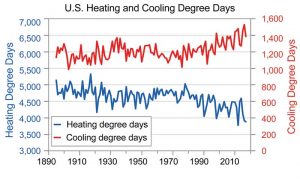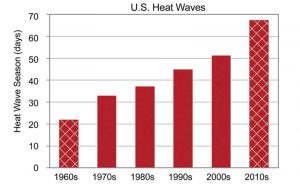
By Kurt Shickman
Rising temperatures are quickly becoming a key challenge for cities and urbanized areas. The effects of heat have negative outcomes for health and well-being, social equity, energy use and peak demand, resilience of health, transportation and electrical infrastructure, crime, education, and productivity. A study of nearly 1700 cities found these combined effects would cost a city which does not address heat approximately 1.7 percent of its annual economic output by 2050 and 5.6 percent by 2100. This could be considered a tax for inaction on rising temperatures measured in the billions of dollars.
When it comes to high temperatures, there is a lot stacked against cities. Cities tend to be hotter than surrounding less-developed areas because they absorb more solar radiation, have less vegetation, release built-up heat more slowly, and generate more waste heat from vehicles and mechanical (or active) cooling. These factors contribute to a phenomenon called the urban heat island (UHI), wherein the annual mean air temperature of a city with 1 million people or more can be two to five degrees warmer than its surroundings. On a clear, calm night, however, the temperature difference can be as much as 22 degrees. This rise in average ambient temperatures is affecting cities in all climates (Figure 1) and increases the frequency, duration, and intensity of extreme heat waves. Since the 1980s, the number of days of extreme heat in the U.S. has nearly doubled (Figure 2).

The intensity and speed of these changes to urban environments will benefit from immediate action, particularly in built environments where people live, learn, and work. Transforming building design and material choices to focus on improving the ability of building occupants and communities, and to mitigate and manage the effects of rising temperature—often referred to as heat resilience—has started to take place in some urban environments. However, it has not reached anywhere near the scale needed to offset the effects of UHIs.
Solutions to improve heat resilience within building enclosures
There are solutions building experts can adopt today to minimize heat gain and reduce temperatures in buildings, in cities, and on the planet. These solutions can be considered in three basic categories.
Passive, non-mechanical cooling solutions, such as:
- Roof, wall, and pavement materials which reflect a greater portion of solar radiation than traditional materials (highly reflective surfaces).
- Expanded vegetated areas and tree canopies (shading, green roofs/walls, and permeable/pervious surfaces).
Heat-resilience planning, such as:
- Natural and human-made water features including lakes, rivers, and fountains (water infrastructure).
- Urban planning which minimizes heat buildup and retention (urban design).
- Passive cooling designs for buildings, like increased thermal insulation (passive building design).
Energy-efficient cooling solutions, such as:
- Energy-efficient cooling technologies and climate-friendly centralized cooling applications, including district cooling.
- Technologies designed to reduce waste heat exhaust, including electric vehicles.

Each of these solutions is an important part of an integrated strategy to build heat resilience. Cool roof and wall materials are widely available in North America and can cover nearly every type of roof and wall structure. Cool roof and wall solutions can be applied at various stages, including when a building is retrofitted, when a roof is being repaired or replaced, or simply over an existing functional roof or wall.
Importantly, for most roof and wall types, there is a cost-comparable cool version which can be specified with minimal maintenance costs. While cool walls are a part of any complete cooling strategy, this article will focus mainly on cool roofs.




